Traditions of Greek Orthodox Church Wedding Ceremony 👰⚭💒🤵
👰⚭💒🤵 Παραδόσεις της τελετής γάμου στην Ελληνική Ορθόδοξη Εκκλησία

Traditions of Greek Orthodox Church Wedding Ceremony 👰⚭💒🤵
BY: Greek Cooking Made Easy
SUBSCRIBE TO MY YOUTUBE CHANNEL: https://www.youtube.com/greekcookingmadeeasy
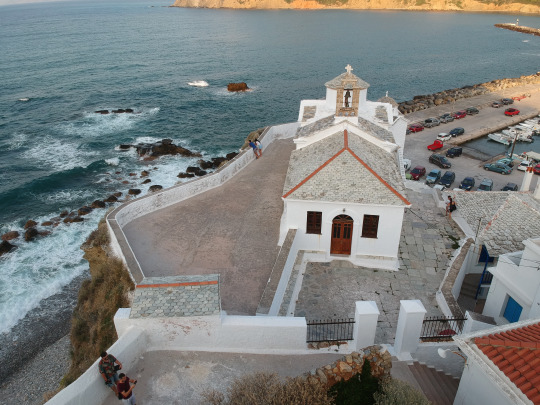
The Greek Orthodox Church Wedding ceremony is filled with traditions observed until today with special meanings and significance.
The wedding ceremony or “Wedding Mystery” as called in the Orthodox church i.e. Sacrament, is composed of two services. The first is the Engagement and the second is the Service of Marriage or Crowning.
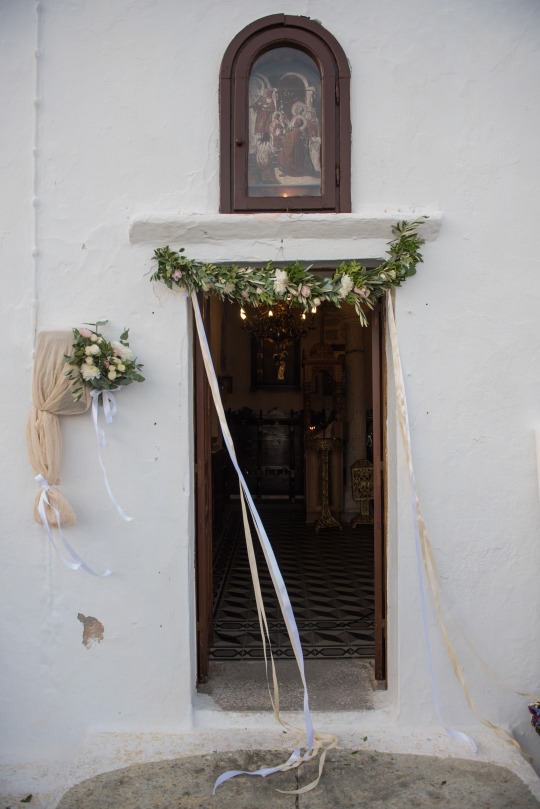
The ritual and traditions of the Greek religious ceremony is as follows:
1. Waiting of the bride:
The groom awaits the bride at the entrance of the church with the bridal bouquet.
The father accompanies the bride to the entrance of the church where the groom offers the bouquet to her, and takes her right hand after her father.
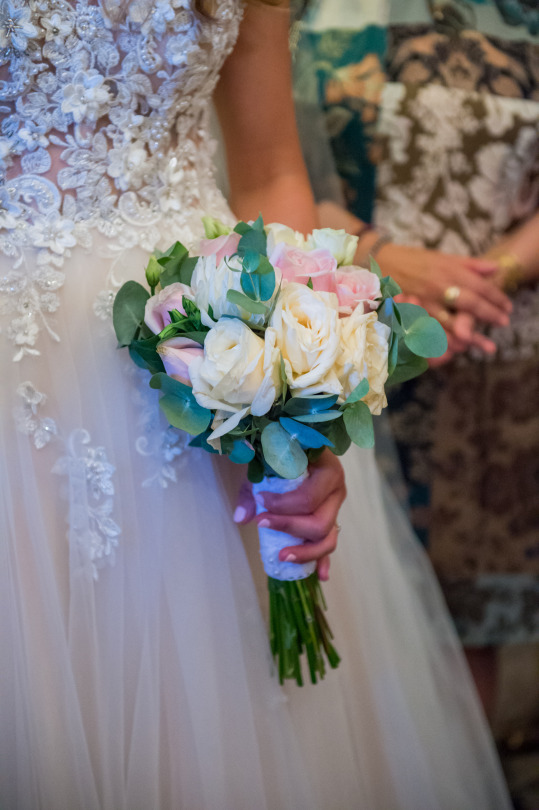
Bride and groom walk together down the aisle followed by their families and all the guests. In front of the altar awaits the Priest next to a table with the tray holding all the necessary objects to conduct the ceremony.
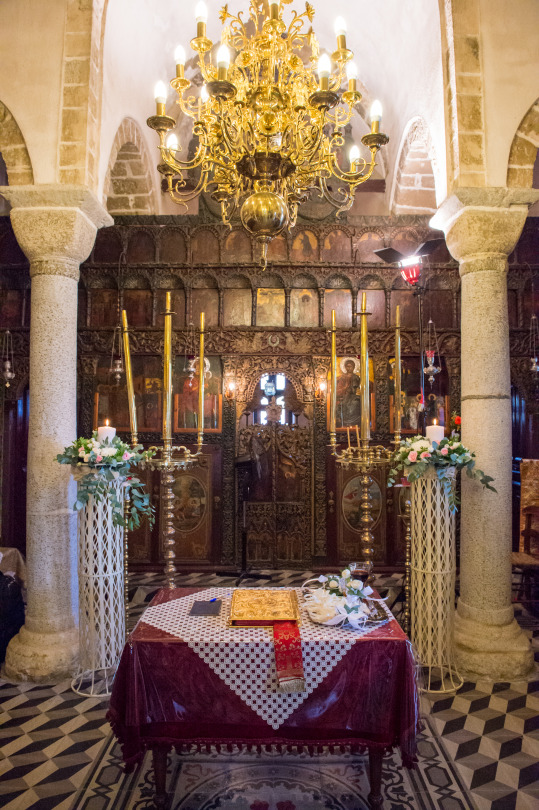
Also present is the koumparo and/or koumpara (best man/woman or main witness) who traditionally purchases the silver tray as a wedding gift to the couple and will exchange the wedding rings and crowns.
The silver tray used in the Greek Orthodox church includes: holy wine and one glass, Stefana-crowns and the Veres-wedding rings in their box.
There are also small koufetta - white sugar coated almonds, placed together with rice and white flower petals. All these represent a sweet life with good "roots" for the couple and a blessed, blossoming, thriving life together!

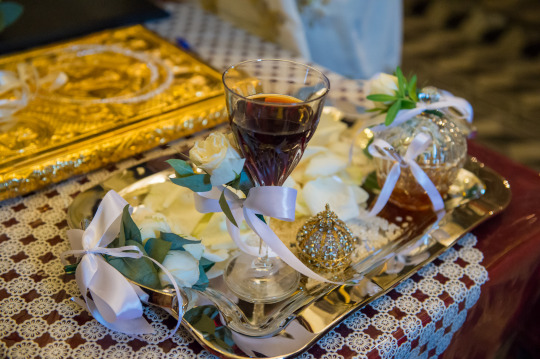
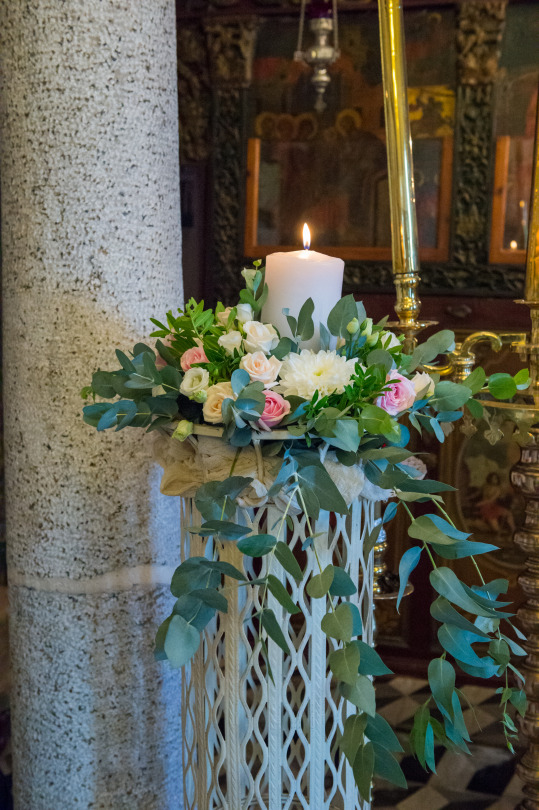
2. The Engagement Service:
The Priest asks God's blessings upon the rings-“Veres” and proceeds to bless the bride and groom with the rings. He places the rings on the ring fingers of the right hands of the couple.
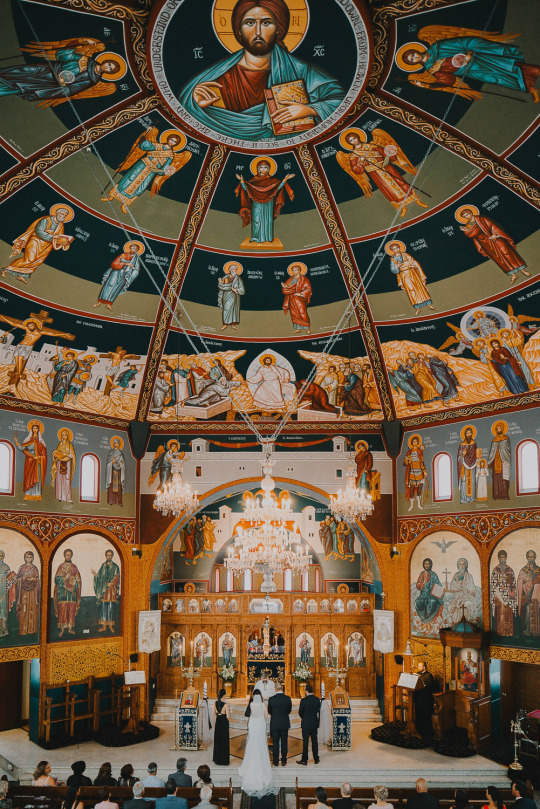

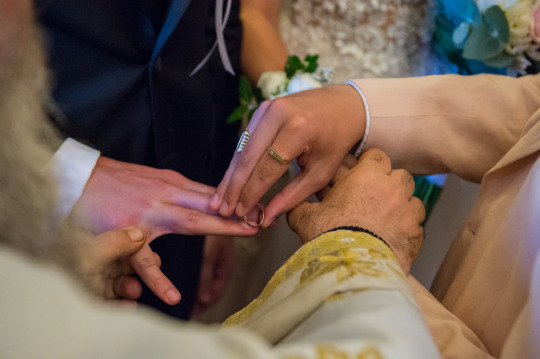
The rings are then exchanged three times on the fingers of the bride and groom by the Best Man. This is a further expression and witness that the lives of the two are being brought together.
3. The Service of Marriage and Crowning:
The Priest takes the two wedding crowns-Stefana from the tray, and blesses the bride and groom, and then places the crowns upon their heads.
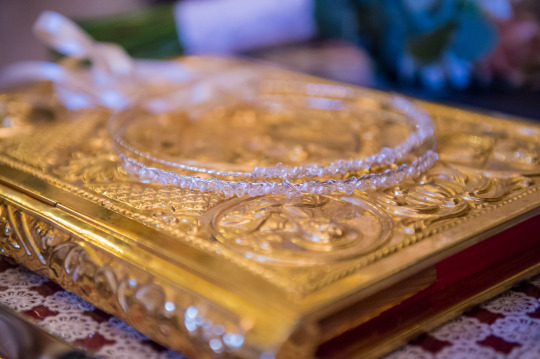

The Koumparos or Koumpara then interchanges the crowns three times as a witness to the sealing of the union. The Stefana are joined by a ribbon which symbolizes the unity of the couple.
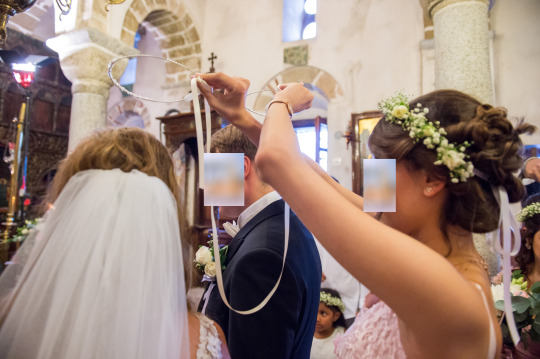
Here are some more Stefana just to see how beautiful they look:

4. The Holy Wine and Common Glass:
While a gospel is read, the Priest serves a small portion of the Holy sweet wine called “Nama” in one glass and presents it to the bride and groom. The wine is blessed by the priest and offered to the now wedded husband and wife, and they each drink three times from the "common glass".
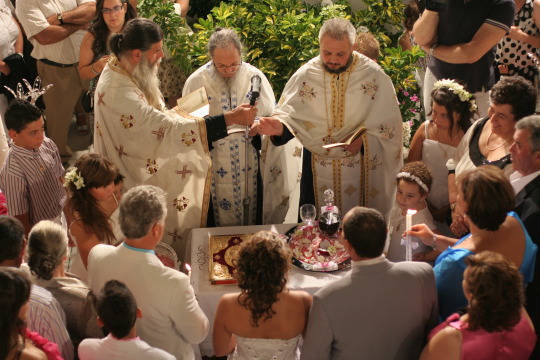
This ritual serves as a witness that the couple shall share everything in life, joy as well as sorrow. Their joy will be doubled and their sorrows halved because they are shared.


5. The Ceremonial Walk called “O Horos tou Isaiah”
The Priest takes the arm of the groom and leads him and his bride followed by the Koumparo around the table three times as an expression of joy. The three-fold walk around the anti-altar is seen as a religious dance. In this respect it is an expression of gratitude to God for His blessings, and joyfulness at the receiving of those blessings.

6. The Removal of the Crowns and the Benediction - The Blessing:
At the conclusion of the ceremonial walk, the priest blesses the groom and the bride as he removes the crowns from their heads, and implores God to grant the newlyweds with a long, happy and fruitful life together.
The priest then lifts up the Gospel and separates the couple's joined hands, reminding them that only God can separate the couple from one another. "What God has joined together, let no man put asunder."
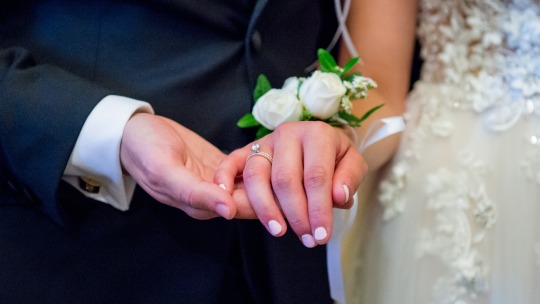
7. Signatures:
Immediately thereafter, bride, groom, koumparos, and priest all sign the official act of marriage while the guests slowly gather outside the church.
8. Rice throwing and guest wedding favours:
As the married couple exits the church, they are bombarded with rice and flower petals by all the guests, representing good “roots” and a blessed, blossoming, reproductive, thriving life together.
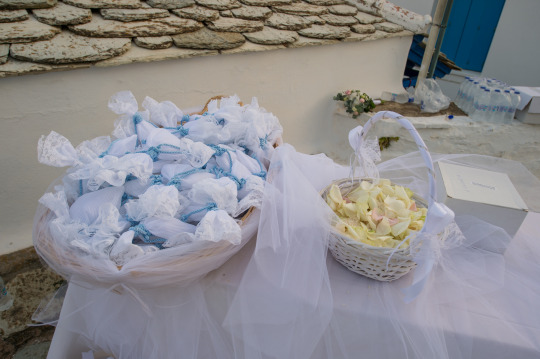
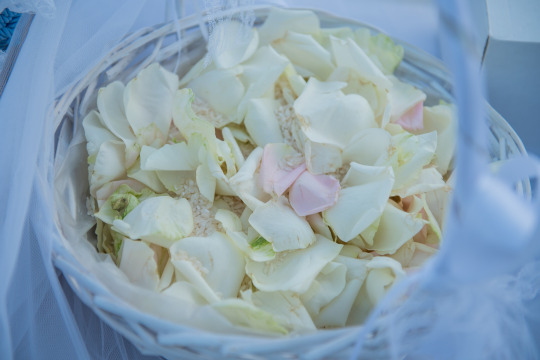
After that the now married couple with their best men and their parents stand outside the church for all the guests to greet them and wish them “A life spread with flower petals -Vio anthosparto”.
A couple of bridesmaids usually stand beside the couple and offer a small favour to the guests called boubouniera i.e. a small box with koufetta-sugar coated almond candy.
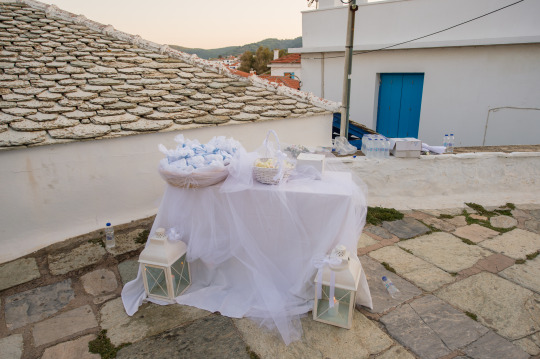
This is an example of the guest favours given outside the church after the religious ceremony, called "Boubouniera". They contain the small “koufetta”!
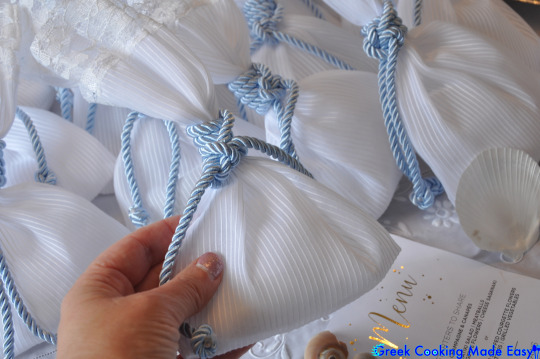
Here are other examples of Bobonieres just to give you an idea! There are so many and all so beautiful!!

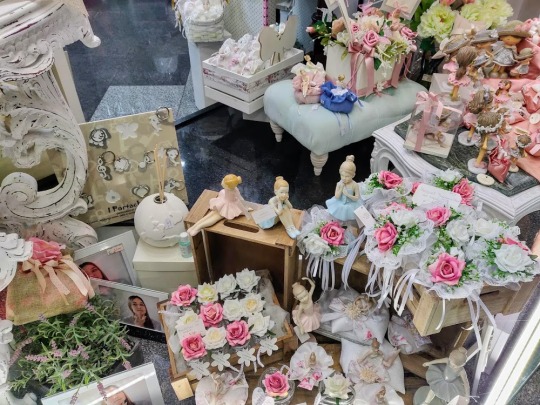

The Boubounieres are made with white color which symbolizes the happy days shared by the couple, their sweet taste the life that awaits and the almond inside the fertility and the successors they will get!
The custom behind Boubounieres or Bombonieres, originated 300 years ago in Greece. Bombonieres were given to the guests as a thank you for honouring the wedding with their presence. Wedding Bombonieres consist of an uneven number of sugar coated almonds (usually 5-7-9), representing the bittersweet life of a married couple.
In some cases, the bridesmaids offer also a small sweet to the guests, like these traditional “Hamalia” offered in the island of Skopelos, shown in the photo.
Check the recipe for the exquisite Hamalia HERE

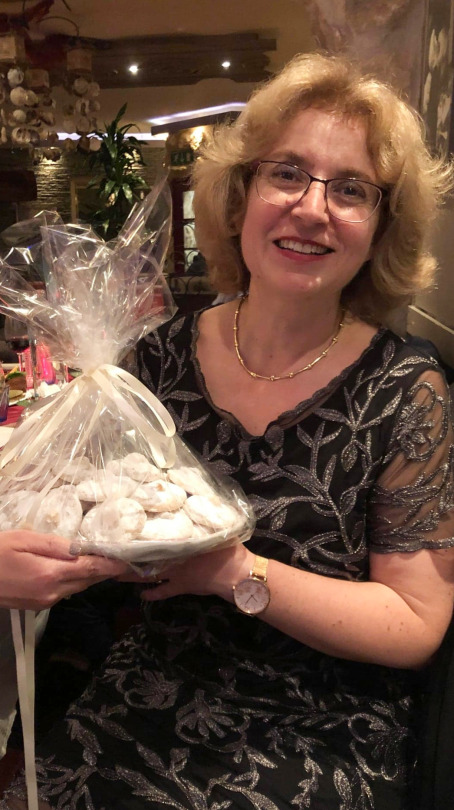
Wedding favors are undoubtedly an integral part of the Greek wedding.
It is the little souvenir that guests treasure forever 💖!
In various places around Greece, the traditional wedding sweets offered as a treat are among others: Kourabiedes, Melomakarona, Diples, fried Loukoumades or Skaltsounia!
You can see find all these special recipes, by clicking HERE
For ideas how to host your own Bridal Shower with a Greek Theme “High Tea”, click HERE

Thank you for reading through my small tribute!


Παραδόσεις της τελετής γάμου στην Ελληνική Ορθόδοξη Εκκλησία 👰⚭💒🤵
BY: Greek Cooking Made Easy
SUBSCRIBE TO MY YOUTUBE CHANNEL: https://www.youtube.com/greekcookingmadeeasy
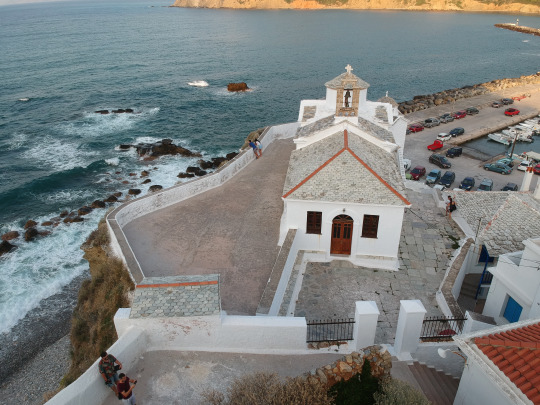
Η τελετή γάμου της Ελληνικής Ορθόδοξης Εκκλησίας είναι γεμάτη με παραδόσεις που ακολουθούνται μέχρι και σήμερα με ιδιαίτερες έννοιες και σημασία.
Η γαμήλια τελετή ή το "Μυστήριο του Γάμου" όπως ονομάζεται στην Ορθόδοξη εκκλησία, αποτελείται από δύο μέρη. Το πρώτο είναι ο Αρραβώνας και το δεύτερο είναι ο Γάμος ή η Ένωση.

Το τελετουργικό και οι παραδόσεις της Ελληνικής θρησκευτικής τελετής είναι οι εξής:
1. Αναμονή της νύφης:
Ο γαμπρός περιμένει τη νύφη στην είσοδο της εκκλησίας με τη νυφική ανθοδέσμη.
Ο πατέρας συνοδεύει τη νύφη στην είσοδο της εκκλησίας όπου ο γαμπρός προσφέρει το μπουκέτο και παίρνει το δεξί χέρι της νύφης από τον πατέρα της.

Νύφη και γαμπρός περπατούν μαζί στο διάδρομο, ακολουθούμενοι από τις οικογένειές τους και όλους τους επισκέπτες. Μπροστά από το ιερό περιμένει ο Ιερέας δίπλα στο τραπέζι με το δίσκο που έχει όλα τα απαραίτητα αντικείμενα για να διεξαχθεί η τελετή.

Εκεί στέκεται και ο Κουμπάρος και / ή η Κουμπάρα που παραδοσιακά έχει αγοράσει τον ασημένιο δίσκο ως γαμήλιο δώρο στο ζευγάρι και που θα ανταλλάξει τις βέρες και τα Στέφανα.
Παραδοσιακά ο ασημένιος δίσκος που χρησιμοποιείται στην Ελληνορθόδοξη εκκλησία περιλαμβάνει: γλυκό κρασί και ένα ποτήρι, τα Στέφανα & τις βέρες.
Στο δίσκο υπάρχουν επίσης κουφέτα, τοποθετημένα μαζί με ρύζι και λευκά ροδοπέταλα. Όλα αυτά αντιπροσωπεύουν μια γλυκιά ζωή με καλές "ρίζες" για το ζευγάρι και μια ευλογημένη, ανθισμένη, ακμάζουσα ζωή μαζί!
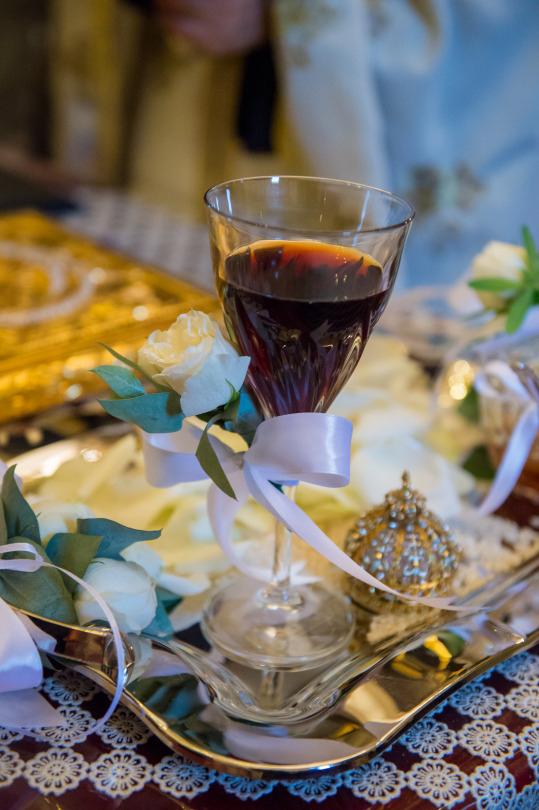


2. Ο Αρραβώνας:
Ο Ιερέας ζητάει τις ευλογίες του Θεού πάνω στις Βέρες και συνεχίζει ευλογώντας τη νύφη και τον γαμπρό με τα δαχτυλίδια. Τοποθετεί τα δαχτυλίδια στο 2ο δάκτυλο του δεξιού χεριού του ζευγαριού.



Στη συνέχεια τα δακτυλίδια ανταλλάσσονται τρεις φορές στα δάκτυλα της νύφης και του γαμπρού από τον Κουμπάρο. Αυτή είναι μια περαιτέρω έκφραση και μαρτυρία ότι οι ζωές των δύο γίνονται μία.
3. Ο Γάμος:
Ο Ιερέας παίρνει τα δύο Στέφανα από το δίσκο, ευλογεί τη νύφη και τον γαμπρό και στη συνέχεια τοποθετεί τα στέφανα στα κεφάλια τους.


Ο Κουμπάρος ή η Κουμπάρα τότε ανταλλάσσει τα στέφανα τρεις φορές ως μάρτυρας της σφράγισης της ένωσης. Τα Στέφανα είναι ενωμένα με μια κορδέλα που συμβολίζει την ενότητα του ζευγαριού.

Να και άλλα στέφανα για να δείτε πόσο όμορφα είναι!

4. Το ιερό κρασί και το κοινό ποτήρι:
Ενώ διαβάζεται το ευαγγέλιο, ο Ιερέας σερβίρει λίγο γλυκό κρασί που ονομάζεται "Νάμα" σε ένα ποτήρι και το παρουσιάζει στη νύφη και τον γαμπρό.

Το κρασί είναι ευλογημένο από τον Ιερέα και προσφέρεται στο ζευγάρι και κάθε ένας πίνει τρεις φορές από το "κοινό ποτήρι".


Αυτό το τελετουργικό υποδηλώνει ότι το ζευγάρι θα μοιράζεται τα πάντα στη ζωή, τη χαρά καθώς και τη θλίψη. Η χαρά τους θα διπλασιαστεί και οι θλίψεις τους θα μειωθούν στο μισό, επειδή είναι κοινές.
5. Ο Χορός του Ησαΐα:
Ο ιερέας παίρνει το χέρι του γαμπρού και τον οδηγεί μαζί με τη νύφη, ακολουθούμενοι από το Κουμπάρο γύρω από το τραπέζι τρεις φορές ως έκφραση χαράς. Ο τριπλός χορός γύρω από το τραπέζι θεωρείται θρησκευτικός χορός. Είναι μια έκφραση ευγνωμοσύνης προς τον Θεό για τις ευλογίες Του και χαρά για τη λήψη αυτής της ευλογίας.

6. Η Ευλογία:
Στο τέλος του χορού του Ησαΐα, ο ιερέας ευλογεί τον γαμπρό και τη νύφη καθώς αφαιρεί τα στέφανα από τα κεφάλια τους και παρακαλεί τον Θεό να παραχωρήσει στους νεόνυμφους μια μακρά, ευτυχισμένη και καρποφόρα ζωή μαζί.
Ο ιερέας τότε ανυψώνει το Ευαγγέλιο και χωρίζει τα ενωμένα χέρια του ζευγαριού, υπενθυμίζοντάς τους ότι μόνο ο Θεός μπορεί να χωρίσει το ζευγάρι λέγοντας: "Ους ο Θεός συνέζευξεν, άνθρωπος μη χωριζέτω"

7. Υπογραφές:
Αμέσως μετά, η νύφη, ο γαμπρός, ο κουμπάρος/οι και ο ιερέας υπογράφουν την επίσημη πράξη του γάμου, ενώ οι καλεσμένοι συγκεντρώνονται αργά έξω από την εκκλησία.
8. Ρίψιμο ρυζιού και οι Μπουμπουνιέρες των επισκεπτών:
Καθώς το παντρεμένο ζευγάρι βγαίνει από την εκκλησία, βομβαρδίζονται με ρύζι και ροδοπέταλα από όλους τους καλεσμένους, που αντιπροσωπεύουν καλές "ρίζες" στο γάμο και μια ευλογημένη, ανθισμένη, ακμάζουσα ζωή μαζί.


Μετά από αυτό το παντρεμένο ζευγάρι με τους κουμπάρους και τους γονείς τους στέκονται έξω από την εκκλησία για να τους χαιρετίσουν όλοι οι καλεσμένοι και να τους ευχηθούν «Βίο Ανθόσπαρτο».
Μερικές παράνυμφοι συνήθως στέκονται δίπλα στο ζευγάρι και προσφέρουν ένα μικρό αναμνηστικό στους καλεσμένους που ονομάζεται Μπουμπουνιέρα, δηλαδή ένα μικρό κουτί με κουφέτα.

Αυτή η φωτογραφία δείχνει ένα τύπο Μπουμπουνιέρας για τους καλεσμένους που δίνονται έξω από την εκκλησία μετά την θρησκευτική τελετή.

Να και μερικές ακόμα Μπομπονιέρες για να δείτε πόσο όμορφες είναι:



Το λευκό χρώμα στις μπουμπουνιέρες συμβολίζει τις ευτυχισμένες μέρες που θα μοιραστεί το ζευγάρι, η γλυκιά τους γεύση τη ζωή που τους περιμένει και το αμύγδαλο μέσα τη γονιμότητα και τους διαδόχους που θα έχουν!
Το έθιμο πίσω από τις Μπουμπουνιέρες, ξεκίνησε πριν από 300 χρόνια στην Ελλάδα. Οι Μπουμπουνιέρες μοιραζόντουσαν στους επισκέπτες σαν ευχαριστώ που τίμησαν με την παρουσία τους το γάμο. Οι γαμήλιες μπομπονιέρες αποτελούνται από μονό αριθμό κουφέτων (συνήθως 5-7-9), που αντιπροσωπεύουν τη γλυκόπικρη ζωή του παντρεμένου ζευγαριού.
Σε μερικές περιπτώσεις οι παράνυμφοι προσφέρουν και άλλα γλυκάκια στους καλεσμένους, όπως αυτά τα παραδοσιακά Χαμαλιά στη παρακάτω φωτο, στο νησί της Σκοπέλου!
Κοιτάξτε τη συνταγή μου για τα φανταστικά Χαμαλιά ΕΔΩ
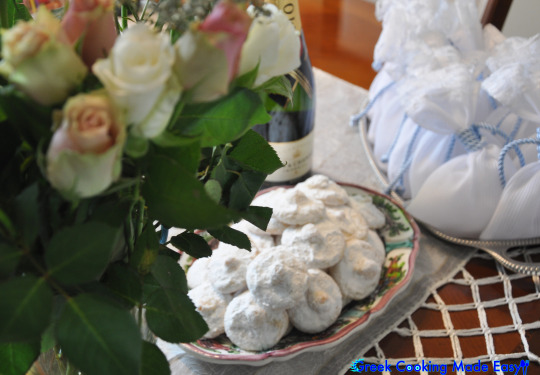

Οι Μπουμπουνιέρες είναι αναμφίβολα ένα αναπόσπαστο κομμάτι του Ελληνικού γάμου. Είναι το μικρό αναμνηστικό που κρατούν οι επισκέπτες για πάντα 💖!
Υπάρχουν και άλλα γλυκά που προσφέρονται σε διάφορα μέρη της Ελλάδας, σαν παραδοσιακό κέρασμα σε γάμους όπως: οι Κουραμπιέδες, τα Μελομακάρονα, τα Σκαλτσούνια, οι Λουκουμάδες με μέλι και οι Δίπλες.
Κοιτάξτε τις Συνταγές μου για αυτά τα σπέσιαλ Γλυκά ΕΔΩ
Αν θέλετε ιδέες για να φτιάξετε Νυφικό Πάρτυ-Απογευματινό Τσάι «High Tea», Με Θέμα Την “Ελληνική Θάλασσα”, κοιτάξτε ΕΔΩ

Σας ευχαριστώ που διαβάσατε το μικρό μου αφιέρωμα!


